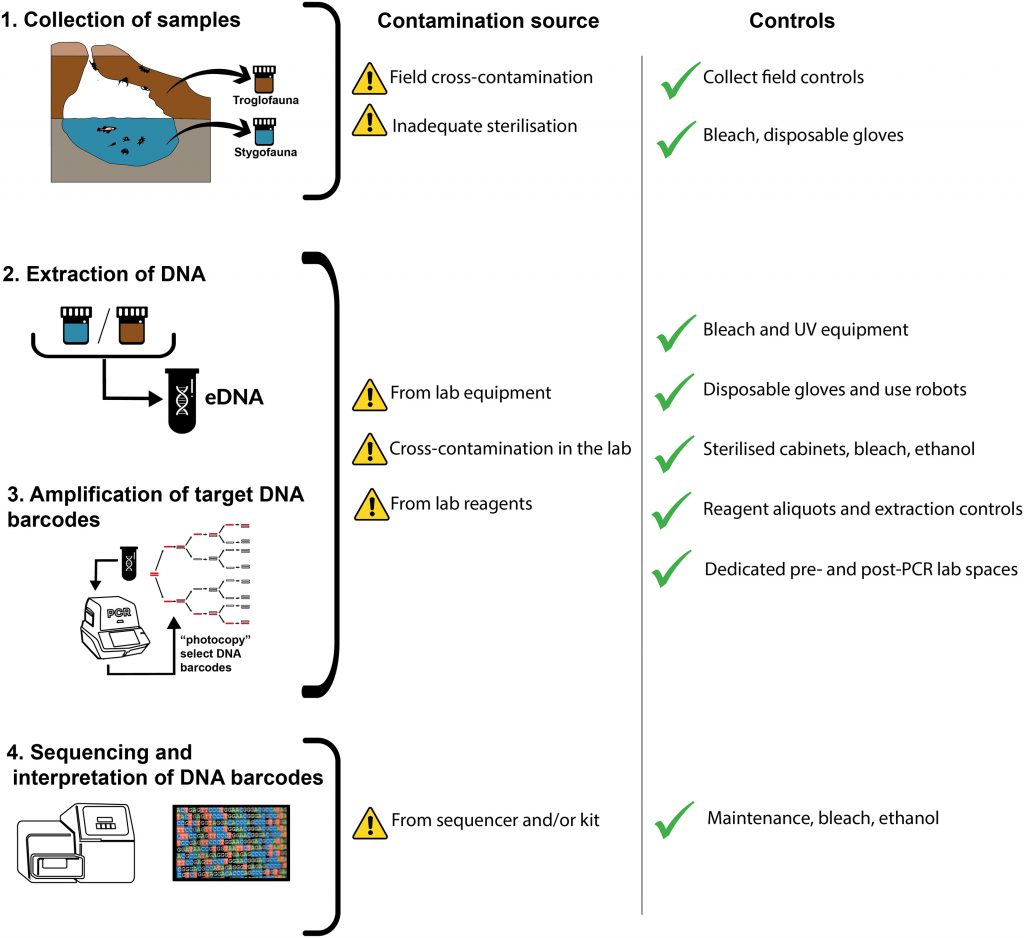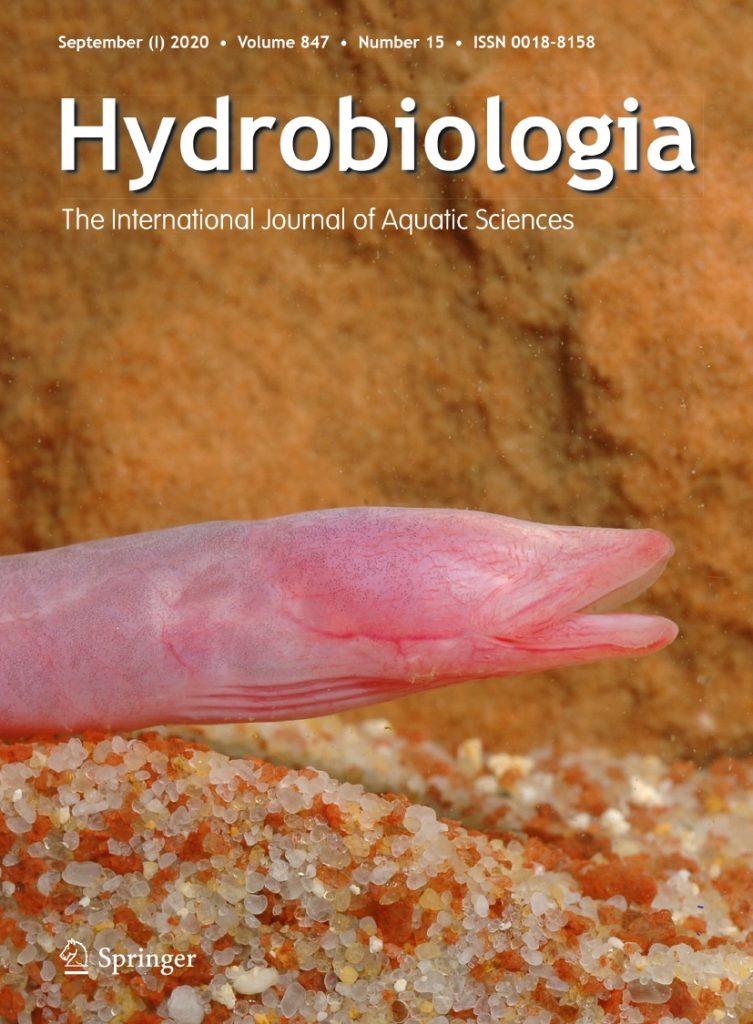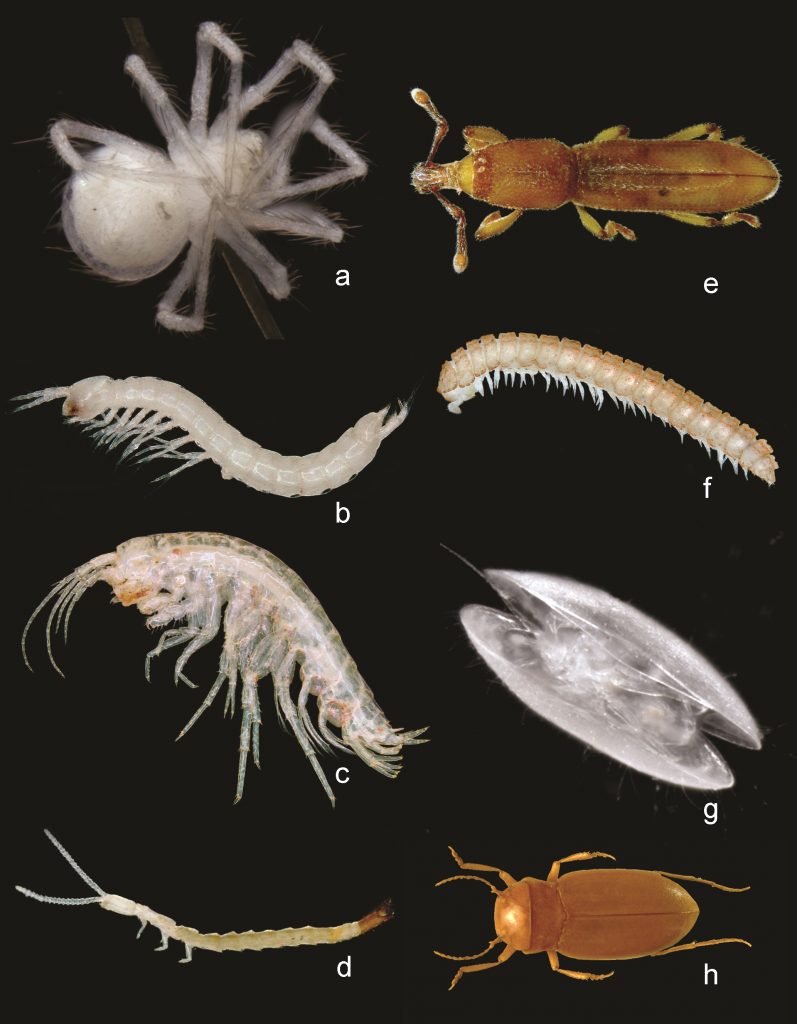
Our review on the conceptual and technical application of eDNA to subterranean ecosystems.
Sacco et al. (2022)

We demonstrate that eDNA can be successfully used to detect subterranean fauna, including the Blind Cave Eel which is listed under Commonwealth conservation legislation.
White et al. (2020)

We identified the western part of the Australia as a region of extremely rich biodiversity for subterranean fauna with a projected 4140 stygobitic and troglobitic species. A significant subterranean fauna is also likely to occur across the eastern part of the continent.
Guzik et al. (2010)
Guzik, M.T., Coates, P.J., Humphreys, W.F., Hillyer, M.J., Wilson, N.J., Hosie, A.M., Kirkendale, L., Alexander, J., O’Neill, C., Huey, J.A., King, R.A, Cooper, S.J.B., Austin, A.D. (In Prep) A Barcode Reference Library for biodiversity assessment of a subterranean community in the Pilbara, Western Australia. Invertebrate Systematics.
van der Heyde, White, N.E. Nevill, P., Austin, A.D, Stevens, N., Jones, M. and Guzik, M.T. (In press) Taking eDNA underground: factors affecting eDNA detection of subterranean fauna in groundwater. Molecular Ecology Resources.
Beasley-Hall, P. G., Murphy, N. P., King, R. A., White, N. E., Hedges, B. A., Cooper, S. J. B., Austin, A. D., Guzik, M. T. (In press) The ecologically and culturally significant Great Artesian Basin-dependent springs of South Australia: importance, threats, and future directions. Frontiers in Environmental Science.
Austin A.D., Guzik, M.T., Jones, K., Humphreys, W., Watts, C., Cooper, S.J.B. (In press) The Unique Australian Subterranean Dytiscidae: Diversity, Biology, and Evolution. In (Ed.) Yee, D.A., Ecology, Systematics, and the Natural History of Predaceous Diving Beetles (Coleoptera: Dytiscidae). Springer Nature Switzerland AG Switzerland
Stringer, D. N., King, R. A., Austin, A.D. and Guzik, M.T. (In Press) Pilbarana, a new subterranean amphipod genus (Hadzioidea: Eriopisidae) of environmental assessment importance from the Pilbara, Western Australia, Zootaxa.
McDonald, T., Bateman, P. W., Cooper, C., van der Heyde, M., Mousavi-Derazmahalleh, M., Hedges, B., Guzik, M. T., Nevill, P. (In press) Detection of vertebrates from natural and artificial arid land water bodies using active and passive sampling of eDNA. Science of the Total Environment.
Saccò, M., Blyth, A.J., Douglas, G., Humphreys, W.F., Hose, G., Davis, J., Guzik, M.T., and Halse, S. (In press) Stygofauna coast to coast: a review on the conservation of Australian coastal aquifer ecosystems. Science of the Total Environment.
Saccò, M.*, Guzik, M.T.*, van der Heyde, M.; Nevill, P., Cooper, S.B.J. Austin, A.D, Coates, P.J., Allentoft, A. E. and White, N.E. (2022) eDNA in subterranean ecosystems: applications, technical aspects and future prospects. Science of the Total Environment. 820: 153223.
White, N. E., Guzik, M. T., Austin, A. D., Moore, G. I., Humphreys, W. F., Alexander, J., & Bunce, M. (2020). Detection of the rare Australian endemic blind cave eel (Ophisternon candidum) with environmental DNA: implications for threatened species management in subterranean environments. Hydrobiologia, 847(15), 3201-3211.
Guzik, M. T., Stevens, M. I., Cooper, S. J. B., Humphreys, W. F., & Austin, A. D. (2020). Extreme genetic diversity among springtails (Collembola) in subterranean calcretes of arid Australia. Genome, 1-15.
Matthews, E., Abrams, K., Cooper, S., Huey, J., Hillyer, M., Humphreys, W., Austin, A.D. & Guzik, M. T. (2020). Scratching the surface of subterranean biodiversity: molecular analysis reveals a diverse and previously unknown fauna of Parabathynellidae (Crustacea: Bathynellacea) from the Pilbara, Western Australia. Molecular Phylogenetics and Evolution, 142, 106643.
DeBoo, M. L., Murphy, N. P., Austin, A. D., Watts, C. H. S., & Guzik, M. T. (2019). Arid zone island hopping: the impact of dispersal on endemism in hydraenid beetles (Coleoptera: Hydraenidae) found in isolated desert springs. Austral Entomology, 58(4), 886-896.
Guzik, M. T., Stringer, D., Murphy, N., Cooper, S., Taiti, S., King, R., Humphreys, W.F. & Austin, A. (2019). Molecular phylogenetic analysis of Australian arid-zone oniscidean isopods (Crustacea: Haloniscus) reveals strong regional endemicity and new putative species. Invertebrate Systematics, 33(3), 556-574.
Stringer, D. N., King, R. A., Taiti, S., Guzik, M. T., Cooper, S. J. B., & Austin, A. D. (2019). Systematics of Haloniscus Chilton, 1920 (Isopoda: Oniscidea: Philosciidae), with description of four new species from threatened Great Artesian Basin springs in South Australia. Journal of Crustacean Biology, 39(5), 651-668.
Murphy, N., Guzik, M. T., Cooper, S., & Austin, A. (2015). Desert spring refugia: museums of diversity or evolutionary cradles?. Zoologica Scripta, 44(6), 693-701.
Karanovic, T., Eberhard, S., Cooper, S., & Guzik, M. T. (2015). Morphological and molecular study of the genus Nitokra (Crustacea, Copepoda, Harpacticoida) in a small palaeochannel in Western Australia. Organisms Diversity and Evolution, 15(1), 65-99.
Strugnell, J., Norman, M., Vecchione, M., Guzik, M. T., & Allcock, A. (2014). The ink sac clouds octopod evolutionary history. Hydrobiologia, 725(1), 215-235.
Robertson, H., Guzik, M. T., & Murphy, N. (2014). Persistence in the desert: ephemeral waterways and small-scale gene flow in the desert spring amphipod, Wangiannachiltonia guzikae. Freshwater Biology, 59(4), 653-665.
Harrison, S., Guzik, M. T., Harvey, M., & Austin, A. (2014). Molecular phylogenetic analysis of Western Australian troglobitic chthoniid pseudoscorpions (Pseudoscorpiones:Chthoniidae) points to multiple independent subterranean clades. Invertebrate Systematics, 28(4), 386-400.
Abrams, K., King, R., Guzik, M. T., Cooper, S., & Austin, A. (2013). Molecular phylogenetic, morphological and biogeographic evidence for a new genus of parabathynellid crustaceans (Syncarida:Bathynellacea) from groundwater in an ancient southern Australian landscape. Invertebrate Systematics, 27(2), 146-172.
Bradford, T., Adams, M., Guzik, M. T., Humphreys, W., Austin, A., & Cooper, S. (2013). Patterns of population genetic variation in sympatric chiltoniid amphipods within a calcrete aquifer reveal a dynamic subterranean environment. Heredity, 111(1), 77-85.
Guzik, M. T. and Murphy, N.P. (2013) Fauna of the GAB Springs: comparative phylogeography of GAB spring invertebrates. In: Gotch, T.G. (Ed) Volume V: Allocating Water and maintaining springs in the GAB: Groundwater Dependent Ecosystems, National Water Commission, Canberra, pp 26-41.
Murphy, N., Adams, M., Guzik, M. T., & Austin, A. (2013). Extraordinary micro-endemism in Australian desert spring amphipods. Molecular Phylogenetics and Evolution, 66(3), 645-653.
Cook, B., Abrams, K., Marshall, J., Perna, C., Choy, S., Guzik, M. T., & Cooper, S. (2012). Species diversity and genetic differentiation of stygofauna (Syncarida: Bathynellacea) across an alluvial aquifer in north-eastern Australia. Australian Journal of Zoology, 60(3), 152-158.
Murphy, N., Breed, M., Guzik, M. T., Cooper, S., & Austin, A. (2012). Trapped in desert springs: phylogeography of Australian desert spring snails. Journal of Biogeography, 39(9), 1573-1582.
Guzik, M. T., Adams, M., Murphy, N., Cooper, S., & Austin, A. (2012). Desert springs: deep phylogeographic structure in an ancient endemic crustacean (Phreatomerus latipes). PLoS One, 7(7), 1-23.
Abrams, K., Guzik, M. T., Cooper, S., Humphreys, W., King, R., Cho, J., & Austin, A. (2012). What lies beneath: Molecular phylogenetics and ancestral state reconstruction of the ancient subterranean Australian Parabathynellidae (Syncarida, Crustacea). Molecular Phylogenetics and Evolution, 64(1), 130-144.
Guzik, M. T., Cooper, S., Humphreys, W., Ong, S., Kawakami, T., & Austin, A. (2011). Evidence for population fragmentation within a subterranean aquatic habitat in the Western Australian desert. Heredity, 107(3), 215-230.
Guzik, M. T., Austin, A., Cooper, S., Harvey, M., Humphreys, W., Bradford, T. Eberhard, S. M., King, R. A., Leys, R., Muirhead, K. A. & Tomlinson, M. (2010). Is the Australian subterranean fauna uniquely diverse? Invertebrate Systematics, 24(5), 407-418.
Murphy, N., Guzik, M. T., & Wilmer, J. (2010). The influence of landscape on population structure of four invertebrates in groundwater springs. Freshwater Biology, 55(12), 2499-2509.
Juan, C., Guzik, M. T., Jaume, D., & Cooper, S. (2010). Evolution in caves: Darwin’s ‘wrecks of ancient life’ in the molecular era. Molecular Ecology, 19(18), 3865-3880.
Guzik, M. T., Cooper, S., Humphreys, W., & Austin, A. (2009). Fine-scale comparative phylogeography of a sympatric sister species triplet of subterranean diving beetles from a single calcrete aquifer in Western Australia. Molecular Ecology, 18(17), 3683-3698.
Guzik, M. T., Abrams, K., Cooper, S., Humphreys, W., Cho, J., & Austin, A. (2008). Phylogeography of the ancient Parabathynellidae (Crustacea : Bathynellacea) from the Yilgarn region of western Australia. Invertebrate Systematics, 22(2), 205-216.
Guzik, M. T., Norman, M., & Crozier, R. (2005). Molecular phylogeny of the benthic shallow-water octopuses (Cephalopoda: Octopodinae). Molecular Phylogenetics and Evolution, 37(1), 235-248.